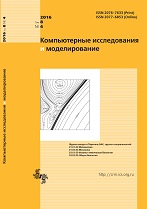|
This article is cited in 4 scientific papers (total in 4 papers)
ANALYSIS AND MODELING OF COMPLEX LIVING SYSTEMS
Hydrodynamical activation of blood coagulation in stenosed vessels.
Theoretical analysis
A. S. Rukhlenkoa, K. E. Zlobinab, G. T. Guriaab
a Moscow Institute of Physics and Technology, 9, Institutskii per., Dolgoprudny, Moscow Region, 141700, Russia
b National Center for Hematology, 4a Novy Zikovsky proezd, Moscow, 125167, Russia
Abstract:
The mechanisms of hydrodynamical activation of blood coagulation system are investigated in
stenosed vessels for a wide range of Reynolds number values (from 10 up to 500). It is assumed that the vessel
wall permeability for procoagulant factors rapidly increases when wall shear stress exceeds specific threshold
value. A number of patterns of blood coagulation processes development are described. The influence of blood
flow topology changes on activation of blood coagulation is explored. It is established that not only blood flow
decrease, but also its increase may promote activation of blood coagulation. It was found that dependence of
thrombogenic danger of stenosis on vessel lumen blockage ratio is non-monotonic. The relevance of obtained
theoretical results for clinical practice is discussed.
Keywords:
mathematical modeling, blood coagulation, vessel stenosis, pattern formation.
Received: 30.01.2012
Revised: 15.02.2012
Citation:
A. S. Rukhlenko, K. E. Zlobina, G. T. Guria, “Hydrodynamical activation of blood coagulation in stenosed vessels.
Theoretical analysis”, Computer Research and Modeling, 4:1 (2012), 155–183
Linking options:
https://www.mathnet.ru/eng/crm478 https://www.mathnet.ru/eng/crm/v4/i1/p155
|

| Statistics & downloads: |
| Abstract page: | 128 | | Full-text PDF : | 48 | | References: | 31 |
|




 Contact us:
Contact us: Terms of Use
Terms of Use
 Registration to the website
Registration to the website Logotypes
Logotypes









 Citation in format
Citation in format 
